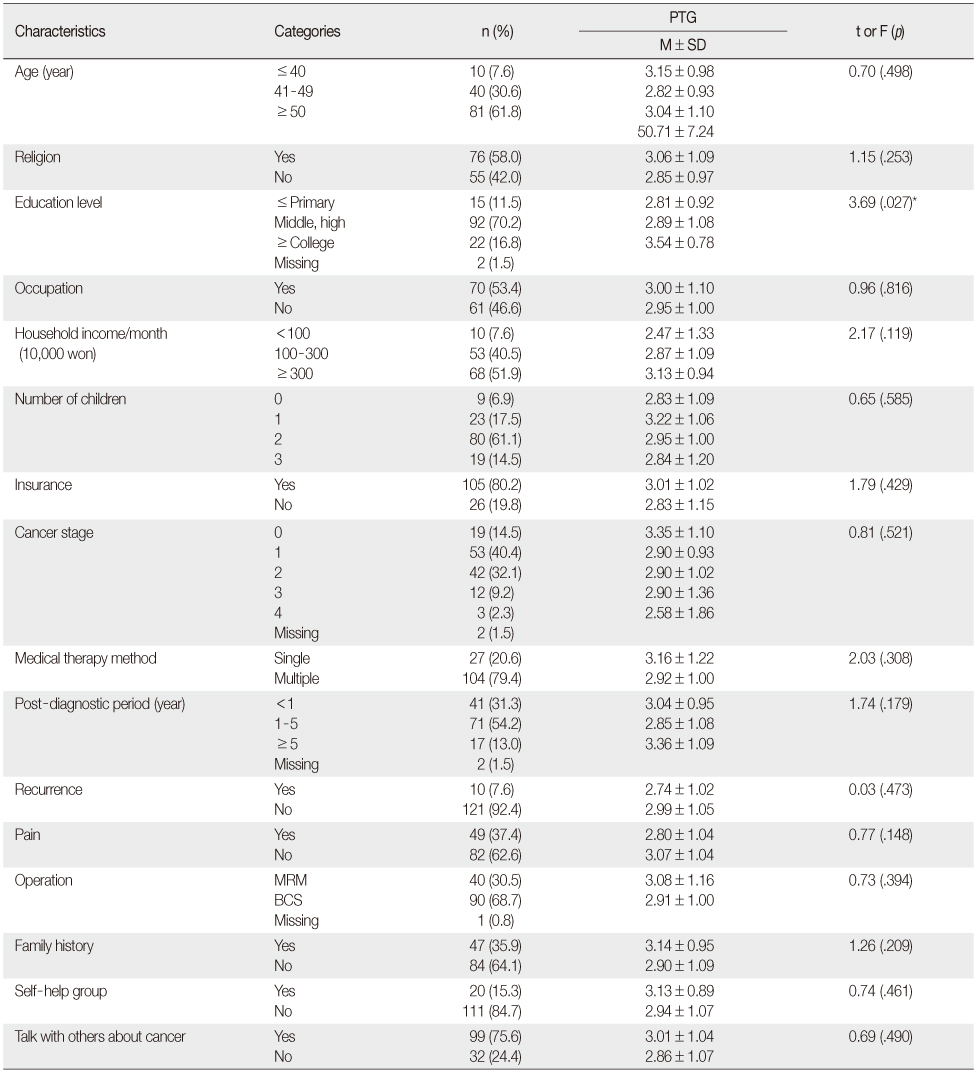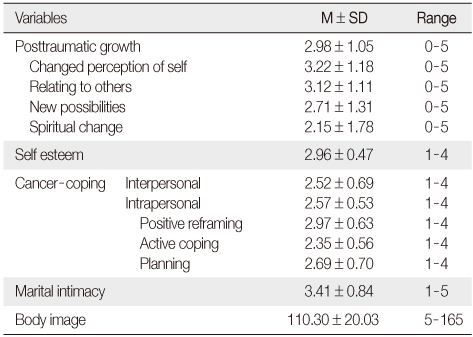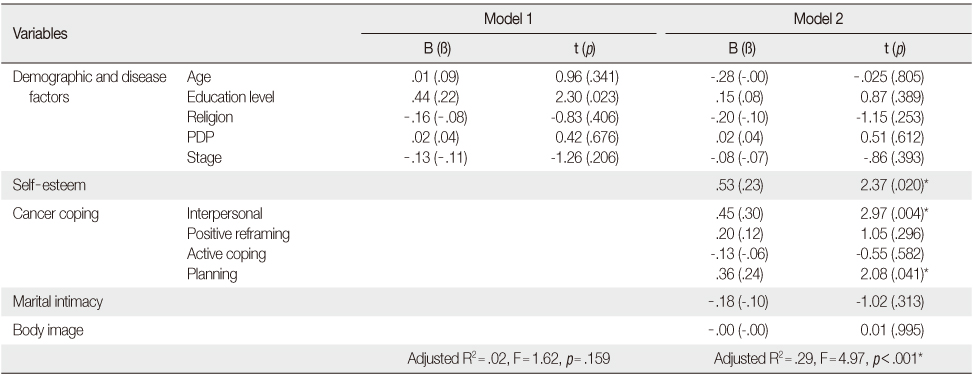Articles
- Page Path
- HOME > J Korean Acad Nurs > Volume 42(6); 2012 > Article
-
Original Article
- Posttraumatic Growth of Patients with Breast Cancer
- Sook Lee, Yeon Jung Kim
-
Journal of Korean Academy of Nursing 2012;42(6):907-915.
DOI: https://doi.org/10.4040/jkan.2012.42.6.907
Published online: December 31, 2012
1Division of Nursing, Dankook University, Cheonan, Korea.
2Counseling and Mediation Center, Dankook University, Cheonan, Korea.
- Address reprint requests to: Kim, Yeon Jung. Counseling and Mediation Center, Dankook University, 119 Dandae-ro, Dongnam-gu, Cheonan 330-714, Korea. Tel: +82-41-550-1295, Fax: +82-41-559-7832, yjkim00@dankook.ac.kr
© 2012 Korean Society of Nursing Science
- 759 Views
- 3 Download
- 20 Crossref
Figure & Data
REFERENCES
Citations

- Structural Equation Model for Psychosocial Adjustment of Breast Cancer Survivors Based on Family Resilience Model
Jiyoung Seo, Myungsun Yi
Korean Journal of Adult Nursing.2022; 34(2): 178. CrossRef - Development and effects of a post-traumatic growth program for patients with breast cancer
Sung Hee Choi, Young Whee Lee, Hwa Soon Kim, Soo Hyun Kim, Eun-Hyun Lee, Eun Young Park, Young Up Cho
European Journal of Oncology Nursing.2022; 57: 102100. CrossRef - Posttraumatic Growth and Health Promotion Behavior in Patients with Cancer: The Mediating Effect of Spiritual Well-Being
Shunji Piao, Pok Ja Oh
Asian Oncology Nursing.2021; 21(1): 33. CrossRef - The effectiveness of acceptance and commitment therapy on the rate of acceptance and post-traumatic growth in colorectal cancer patients comorbid with stress
Ahmad kazemipour, Fazlolah mirderikvand, Kourosh amraei
Health Monitor Journal of the Iranian Institute for Health Sciences Research.2020; 19(5): 569. CrossRef - Post-traumatic Growth among Stroke Patients: Impact of Hope, Meaning in Life, and Social Support
Young-Ju Jeong, Hee Sun Kim
Korean Journal of Adult Nursing.2019; 31(6): 605. CrossRef - A Structural Equation Model of Factors Influencing Posttraumatic Growth of Earthquake Victims
Minyeong Kwak
Journal of Korean Academy of Community Health Nursing.2019; 30(3): 345. CrossRef - Factors Influencing Posttraumatic Growth of Gynecologic Oncology Patients Undergoing Chemotherapy
Sun Jeong Yun, Hye Young Kim
Korean Journal of Women Health Nursing.2019; 25(4): 409. CrossRef - The Influence of Spiritual Well-Being, Self-Esteem, and Perceived Social Support on Post-Traumatic Growth among Breast Cancer Survivors
Eun Young Seo, Suhye Kwon
Asian Oncology Nursing.2018; 18(4): 232. CrossRef - The Relationship between Post-Traumatic Growth, Trauma Experience and Cognitive Emotion Regulation in Nurses
Sook Lee, Mun Gyeong Gwon, YeonJung Kim
Korean Journal of Stress Research.2018; 26(1): 31. CrossRef - Posttraumatic growth in breast cancer survivors and their husbands based on the actor‐partner interdependence model
MyoSuk Lee, Kyunghee Kim, Changwon Lim, Ji‐Su Kim
Psycho-Oncology.2017; 26(10): 1586. CrossRef - Comparison of Perception of Successful Aging between Late Middle-aged Breast Cancer Survivors and Healthy Women
Eun Ja Kim, Nahyun Kim
Journal of Korean Gerontological Nursing.2017; 19(1): 48. CrossRef - Self-Efficacy, Self-Care Behavior, Posttraumatic Growth, and Quality of Life in Patients with Cancer according to Disease Characteristics
Jinho Choi, Sunyoung Lee, Byungduck An
The Korean Journal of Hospice and Palliative Care.2016; 19(2): 170. CrossRef - The Effects of Self-esteem and Problem Focused Coping on Post-traumatic Growth among Police Officers
Seung Woo Han, Eunsuk Choi
Korean Journal of Occupational Health Nursing.2016; 25(3): 141. CrossRef - Factors Influencing Posttraumatic Growth in Survivors of Breast Cancer
Jin-Hee Park, Yong-Sik Jung, Youngmi Jung
Journal of Korean Academy of Nursing.2016; 46(3): 454. CrossRef - Factors Related to Posttraumatic Growth in Patients with Colorectal Cancer
Hyeon Ju Lee, Seong Sook Jun
Korean Journal of Adult Nursing.2016; 28(3): 247. CrossRef - Influencing Factors for Post-traumatic Growth in Patients with Breast Cancer
Sung-Hee Choi, Young-Whee Lee
The Journal of the Korea Contents Association.2016; 16(11): 499. CrossRef - The Effects of Posttraumatic Growth and Meaning in Life on Health Promotion Behavior in Cancer Patients
Sun-Hee Jang, Hae-Rang Lee, Hyung-Nam Yeu, Soon-Ock Choi
Asian Oncology Nursing.2014; 14(2): 100. CrossRef - Posttraumatic Growth, Dyadic Adjustment, and Quality of Life in Breast Cancer Survivors and Their Husbands
Seunghee Song, Eunjung Ryu
Journal of Korean Academy of Nursing.2014; 44(5): 515. CrossRef - Changes of Self-efficacy, Depression, and Posttraumatic Growth in Survivors with Breast Cancer Participating Breast Cancer Prevention Volunteering
Myungsun Yi, Jieun Cha, Youngmi Ryu
The Journal of the Korea Contents Association.2014; 14(4): 256. CrossRef - Effects of a Cancer-Overcome BeHaS Exercise Program on Post-trauma Risk and Anxiety in Breast Cancer Patients
Sun Ae Kim, Jong Im Kim, Sun Young Park
Journal of muscle and joint health.2014; 21(1): 27. CrossRef
Posttraumatic Growth according to Demographic and Disease Characteristics (N=131)
PTG=Posttraumatic growth; MRM=Modified radical mastectomy; BCS=Breast conserving surgery.
Scores for Posttraumatic Growth, Self-esteem, Cancer-coping, Marital Intimacy and Body Image (N=131)
Correlation of Posttraumatic Growth, Self-esteem, Cancer-coping, Marital Intimacy and Body Image (N=131)
Factors related to Posttraumatic Growth (N=131)
PDP=Postdiagnostic period.
PTG=Posttraumatic growth; MRM=Modified radical mastectomy; BCS=Breast conserving surgery.
PDP=Postdiagnostic period.
 KSNS
KSNS
 E-SUBMISSION
E-SUBMISSION




 Cite
Cite

